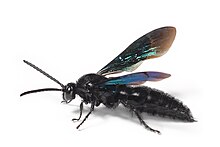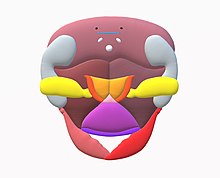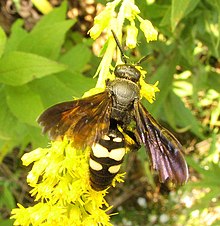Scoliidae
| Scoliidae | |
|---|---|

| |
| Black flower wasp (Austroscolia soror), Australia | |
| Scientific classification | |
| Domain: | Eukaryota |
| Kingdom: | Animalia |
| Phylum: | Arthropoda |
| Class: | Insecta |
| Order: | Hymenoptera |
| Infraorder: | Aculeata |
| Superfamily: | Scolioidea |
| Family: | Scoliidae Latreille, 1802 |
| Subfamilies | |
|
Scoliinae Proscoliinae | |
The Scoliidae, the scoliid wasps, are a family of wasps comprising about 560 species worldwide. They tend to be black, often marked with yellow or orange, and their wing tips are distinctively corrugated. Males are more slender and elongated than females, with significantly longer antennae, but the sexual dimorphism is not as apparent as in many of the Tiphiidae and Thynnidae.
Biology
Scoliid wasps are solitary
Scoliidae also has at least one species known to engage in pseudocopulation with an orchid. Flowers of the orchid Bipinnula penicillata in subtropical South America resemble females of Pygodasis bistrimaculata, tricking male wasps into attempting to mate and, in the process, provide pollination.[1] Scoliids include some of the largest wasps in the world, such as Megascolia procer.[2]
Taxonomy



Living scoliidae genera are classified as follows:[4][5][6]
Subfamily: Proscoliinae
Subfamily: Scoliinae
Tribe: Campsomerini
- Aelocampsomeris Bradley 1957
- Aureimeris Betrem, 1972
- Australelis Betrem, 1962
- Campsomeriella Betrem, 1941
- Campsomeris Lepeletier, 1838
- Cathimeris Betrem, 1972
- Charimeris Betrem, 1971
- Colpa Dufour, 1841
- Colpacampsomeris Betrem, 1967
- Dasyscolia Bradley, 1951
- Dielis Saussure & Sichel, 1864
- Extrameris Betrem, 1972
- Guigliana Betrem, 1967
- Laevicampsomeris Betrem, 1933
- Leomeris Betrem, 1972
- Lissocampsomeris Bradley, 1957
- Megacampsomeris Betrem, 1928
- Megameris Betrem, 1967
- Micromeriella Betrem, 1972
- Peltatimeris Betrem, 1972
- Phalerimeris Betrem, 1967
- Pseudotrielis Betrem, 1928
- Pygodasis Bradley, 1957
- Radumeris Betrem, 1962
- Rhabdotomeris Bradley, 1957
- Sericocampsomeris Betrem, 1941
- Sphenocampsomeris Bradley, 1957
- Stygocampsomeris Bradley, 1957
- Tenebromeris Betrem, 1963
- Trisciloa Gribodo, 1893
- Tristimeris Betrem, 1967
- Tubatimeris Betrem, 1972
- Tureimeris Betrem, 1972
- Xanthocampsomeris Bradley, 1957
Tribe: Scoliini
- Austroscolia Betrem, 1927
- Carinoscolia Betrem, 1927
- Diliacos Saussure & Sichel, 1864
- Laeviscolia Betrem, 1928
- Liacos Guérin-Méneville, 1838
- Megascolia Betrem, 1928
- Microscolia Betrem, 1928
- Mutilloscolia Bradley, 1959
- Pyrrhoscolia Bradley, 1957
- Scolia Fabricius 1775
- Triscoliade Saussure 1863
Subfamily †Archaeoscoliinae
The subfamily Archaeoscoliinae is known exclusively from the fossil record, with the largest diversity having lived during the Cretaceous (Barremian) before going extinct by the late Eocene (Priabonian).
- †Archaeoscolia Rasnitsyn, 1993[8]
- †Archaeoscolia hispanica Rasnitsyn & Martínez-Delclòs, 1999[9]
- †Archaeoscolia senilis Rasnitsyn, 1993[8]
- †Cretoscolia Rasnitsyn, 1993[8]
- †Cretoscolia brasiliensis Osten, 2007[10]
- †Cretoscolia conquensis Rasnitsyn & Martínez-Delclòs, 1999[9]
- †Cretoscolia formosa Zhang, 2004[11]
- †Cretoscolia laiyangica Zhang, 2004[11]
- †Cretoscolia montsecana Rasnitsyn & Martínez-Delclòs, 1999[9]
- †Cretoscolia patiens Rasnitsyn, 1993[8]
- †Cretoscolia promissiva Rasnitsyn, 1993[8]
- †Cretoscolia rasnitsyni Zhang, 2004[11]
- †Floriscolia Rasnitsyn, 1993[8]
- †Floriscolia relicta Rasnitsyn, 1993[8]
- †Protoscolia Zhang et al., 2002[12]
- †Protoscolia imperialis Zhang et al., 2002
- †Protoscolia normalis Zhang et al., 2002
- †Protoscolia sinensis Zhang et al., 2002
Three additional undescribed specimens from the Ypresian Eocene Okanagan Highlands were referred to the subfamily by S. Bruce Archibald et al. (2018). The two fossils from the Klondike Mountain Formation of Northeastern Washington state, and one fossil from the Allenby Formation of South central British Columbia were mentioned briefly but no specific commentary on placement or finer taxonomic detail was presented in the paper.[13]
History
In 1847 and 1849 Eduard Eversmann published his "Fauna Hymenopterologica Volgo-Uralensis—exhibiting the species of Hymenoptera which he observed and described in the provinces situated between the Volga river and the Ural mountains." He placed the Scoliadae LATR. as a subfamily of the Sphegidae LATR. He mentions the genus Scolia FABR. with 13 species, the genus Tiphia FABR. with 3 species, and the genus Meria ILL, with only the species Meria sexpunctata.[14]
North American species list
There are 36 species of Scoliidae reported to occur in North America. Two additional species, Campsomeriella annulata (Fabricius, 1793) and Micromeriella marginella (Klug, 1810), were introduced to the United States but failed to become established.[15][16]
- Aelocampsomeris variegata (Fabricius, 1793) – Mexico, Central America
- Campsomeris atrata (Fabricius, 1775) – Caribbean
- Campsomeris vitripennis (Smith, 1855) – Mexico, Central America
- Colpa (Colpa) octomaculata (Say, 1823) – United States, Mexico
- Colpa (Colpa) pollenifera (Viereck, 1906) – United States, Mexico
- Colpa (Crioscolia) alcione (Banks, 1917) – United States, Mexico
- Colpa (Crioscolia) flammicoma (Bradley, 1928) – United States, Mexico
- Dielis dorsata (Fabricius, 1787) – United States, Caribbean, Mexico, Central America
- Dielis pilipes (Saussure, 1858) – United States, Mexico
- Dielis plumipes (Drury, 1770) – United States
- Dielis tejensis Szafranski, 2023 – United States
- Dielis tolteca (Saussure, 1857) – United States, Mexico, Central America
- Dielis trifasciata (Fabricius, 1793) – United States, Caribbean
- Lissocampsomeris wesmaeli (Lepeletier, 1845) – Mexico, Central America
- Pygodasis ephippium (Say, 1837) – United States, Mexico, Central America
- Pygodasis hyalina (Saussure, 1864) – Mexico
- Pygodasis ianthina (Bradley, 1945) – Mexico, Central America
- Pygodasis vittata (Sichel, 1864) – Mexico, Central America
- Pygodasis quadrimaculata (Fabricus, 1775) – United States
- Rhabdotimeris rokitanskyi (Dalla Torre, 1897) – Mexico, Central America
- Scolia bicincta (Fabricius, 1775) – United States
- Scolia dubia (Say, 1837) – United States, Mexico
- Scolia fuscipennis Bartlett, 1912 – Mexico
- Scolia guttata (Burmeister, 1853) – United States, Mexico, Central America
- Scolia mexicana (Saussure, 1858) – United States, Mexico
- Scolia nobilitata (Fabricius, 1805) – United States, Mexico
- Scolia rufiventris Fabricius, 1804 – Mexico, Central America
- Scolia vintschgaui Dalla Torre, 1893 – Mexico
- Stygocampsomeris servillei (Guérin, 1838) – Mexico, Central America
- Triscolia ardens (Smith, 1855) – United States, Mexico
- Triscolia badia (Saussure, 1863) – Mexico
- Xanthocampsomeris completa (Rohwer, 1927) – United States, Mexico, Central America
- Xanthocampsomeris fulvohirta (Cresson, 1865) – United States, Caribbean
- Xanthocampsomeris hesterae (Rohwer, 1921) – United States, Mexico, Central America
- Xanthocampsomeris limosa (Burmeister, 1853) – United States, Mexico
- Xanthocampsomeris tricincta (Fabricius, 1775) – Caribbean
References
- .
- S2CID 30936410.
- ^ Krombein, Karl V. (1978). "Biosystematic Studies of Ceylonese Wasps, II: A Monograph of the Scoliidae (Hymenoptera: Scolioidea)" (PDF). Smithsonian Contributions to Zoology (283): 6–7. Retrieved 24 September 2021.
- ^ Osten, T. (2005). "Checkliste der Dolchwespen der Welt (Insecta: Hymenoptera, Scoliidae). Teil 1: Proscoliinae und Scoliinae: Campsomerini. Teil 2: Scoliinae: Scoliini. Teil 3: Literatur" [Checklist of the Scoliidae of the World. Part 1: Proscoliinae and Scoliinae: Campsomerini. Part 2: Scoliinae: Scoliini. Part 3: Literature] (PDF). Bericht der Naturforschenden Gesellschaft Augsburg (in German). 62 (220–221): 1–62. Retrieved 2014-06-24.
- ^ "Classification and checklist of Afrotropical mammoth wasps". Retrieved 2019-07-18.
- ^ "BugGuide - Family Scoliidae". Retrieved 2019-07-18.
- ^ "Fauna Europaea". Archived from the original on March 5, 2016.
- ^ a b c d e f g Rasnitsyn, A. (1993). "Archaescoliinae, an extinct subfamily of scoliid wasps (Insecta: Vespida = Hymenoptera: Scoliidae)". Journal of Hymenoptera Research. 2: 85–96.
- ^ .
- ^ Osten, T. (2007). "Hymenoptera: bees, wasps and ants". The Crato Fossil Beds of Brazil: Window into an Ancient World. pp. 350–365.
- ^ .
- .
- S2CID 90017208.
- ^ Eversmann, Eduard (1847). "Fauna Hymenopterologica Volgo-Uralensis I". Bulletin de la Société impériale des naturalistes de Moscou (in Latin). 20 (1): 3–68. (families Tenthredinidae and Uroceratae) and Eversmann, Eduard (1849). "Fauna Hymenopterologica Volgo-Uralensis II". Bulletin de la Société impériale des naturalistes de Moscou (in Latin). 22 (3): 359–436.(family Sphegidae)
- ISBN 1-889002-02-X. Retrieved 2011-10-10.
- ^ Ramírez-Guillén, Luis Damián; Falcon-Brindis, Armando; Gómez, Benigno (2022). "The Scoliidae wasps (Hymenoptera: Scolioidea) of Mexico: taxonomy and biogeography". Zootaxa. 5214 (1): 47–88. .
